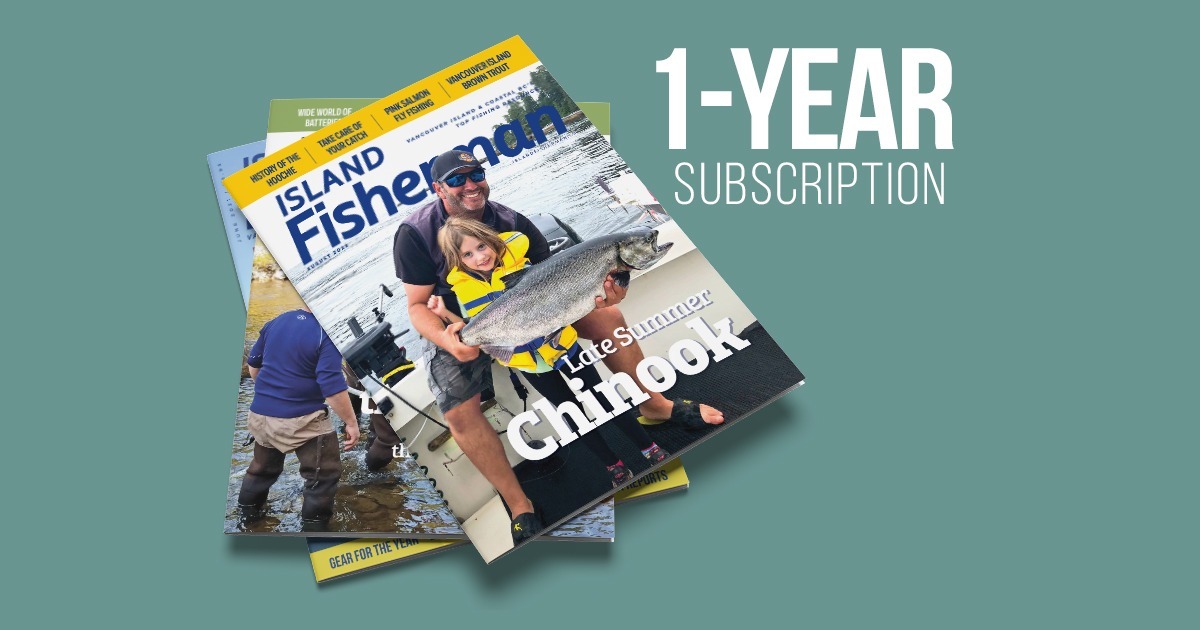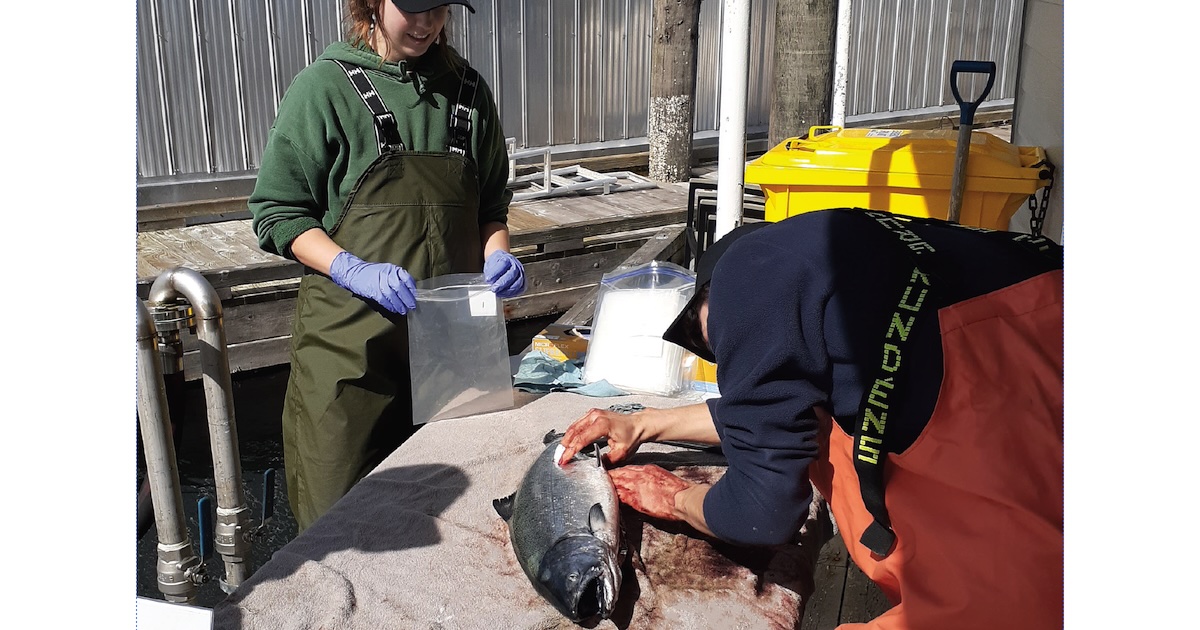
ASDP team members collect entrails from salmon caught during the 2023 Sidney Derby. (Photo: Sidney Anglers Association)
Got Guts? Become Citizen Scientist
By Nathanael Tabert Project Coordinator & Kristina Duchscher, Research Assistant, UVic Adult Salmon Diet Program (ASDP)
The adult salmon diet program (ASDP) was founded in 2017 and aims to monitor salmon and forage fish populations in BC. To date it represents one of the largest and most comprehensive salmon diet studies done anywhere.
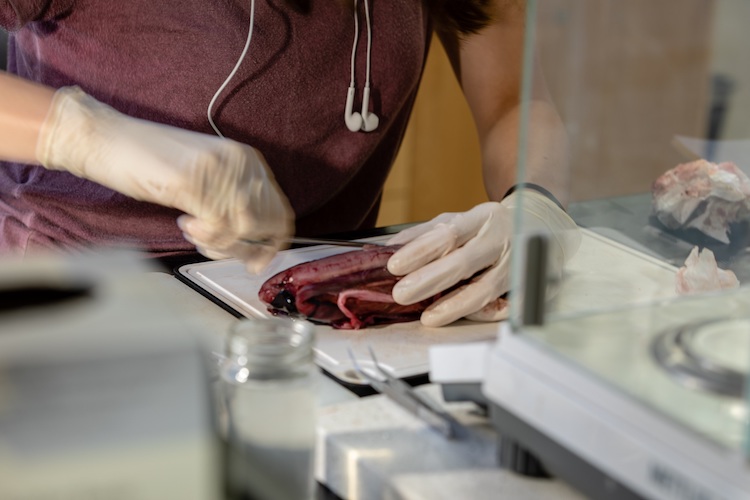
Stomach processing in the lab. Photo courtesy of RAWork Media
What’s most exciting about largely driven by local anglers—our “citizen scientists”—who contribute to research in hopes of furthering our collective understanding of local salmon populations (and maybe winning some new fishing gear—more on that later). The ASDP now enlists the help of more than 250 anglers across coastal British Columbia who donate the stomachs of their catches for analysis. As a result, we have processed more than 5,600 stomachs since 2017. We get to see what salmon eat.
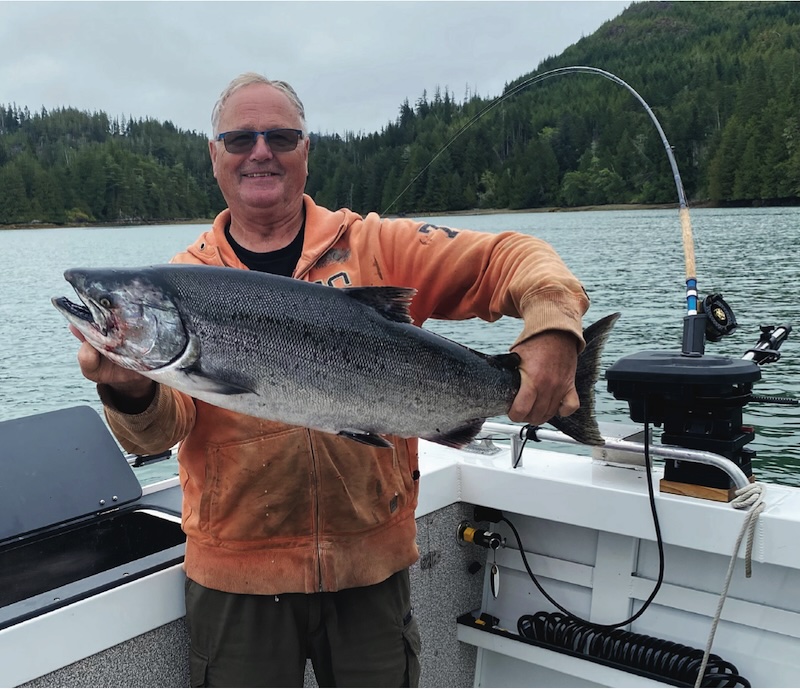
One of our anglers, Gary Wilton, showing off his catch this past spring! (Photo: Gary Wilton)
Salmon Diets as a Tool For Forage Fish Monitoring
Salmon are opportunistic predators, meaning they will feed on whatever is available to them, though different species are adapted to feeding on specific prey types. Our study focuses on Chinook and coho salmon, whose diets are largely comprised of forage fish (small schooling fish such as herring and sand lance). Their opportunistic feeding behaviour means that salmon diets tend to reflect which forage fish are present and most abundant in each region. We can use this information to track changes in coastal food webs.
Salmon Diets in the Past, Present, and Future
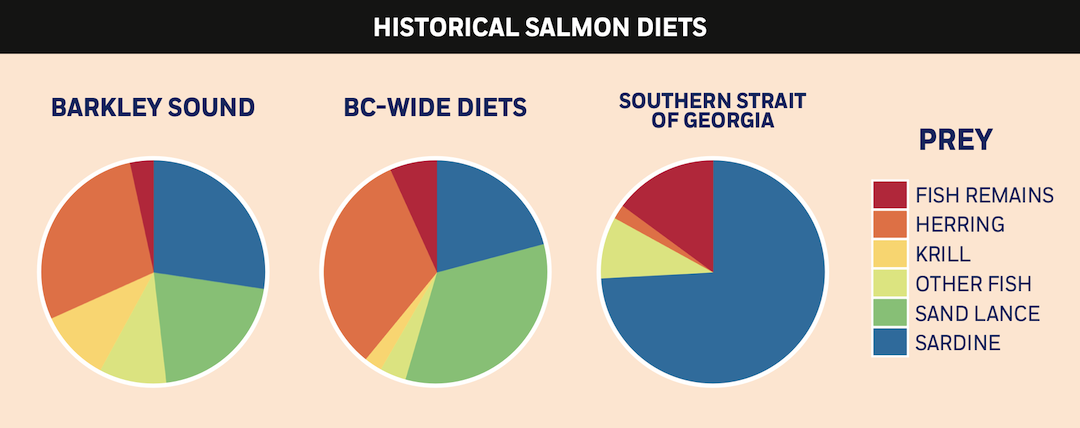
Diet data from salmon stomachs collected in 1940. Look at all those sardines. (Adapted from Pritchard and Tester, 1944)
Before our study began, the most recently published studies on salmon diets in British Columbia were carried out in the 1940s and 1960s. The study in the 40s also used local anglers to collect stomach samples all around BC; the study in the 60s was focused in the Strait of Juan de Fuca. Since then, no large-scale studies on salmon diets in BC have been published until our program began in 2017.
Since forage fish, particularly herring, play a crucial role in the diets of Chinook and coho salmon, the management of herring stocks has received significant attention. However, herring are by no means the only forage fish species that support salmon populations, and by looking at our data along with past diet studies we can identify times and regions where other species have been important. We can also think about how forage fish populations may change in the future and what effects this could have. Here are a few examples:
Sardines as Salmon Food
Sardines are a species of forage fish that spawn in warmer waters, such as those off the coast of California. Most sardines observed in BC have migrated here to feed. However, sardine populations will occasionally experience booms when the populations expand their spawning range. This was the case from the early 1900s to the late 1940s when there were enough sardines in BC waters to support a commercial fishery. They were especially prominent in 1940 when they made up 20% of overall salmon diets and more than 75% of diets in the southern Strait of Georgia.
The sardine population collapsed in 1947, and they were absent from BC waters for a long time. No sardines were observed in the study from the 1960s. It wasn’t until the 1990s that trawl surveys found sardines had returned to the west coast of Vancouver Island. Unfortunately, due to a lack of available data, we don’t know if these sardines became an important part of salmon diets.
Our program did not observe any sardines until 2022, when we found them in six salmon stomachs from the west coast of Vancouver Island and a single stomach collected from Victoria Harbour. While this is certainly not a population boom like in the 1940s, it tells us that sardines may continue to use our waters when conditions are favourable for their survival. It also shows the potential our program has for monitoring changes in forage-fish populations. If sardines return, we will be well positioned to detect it.
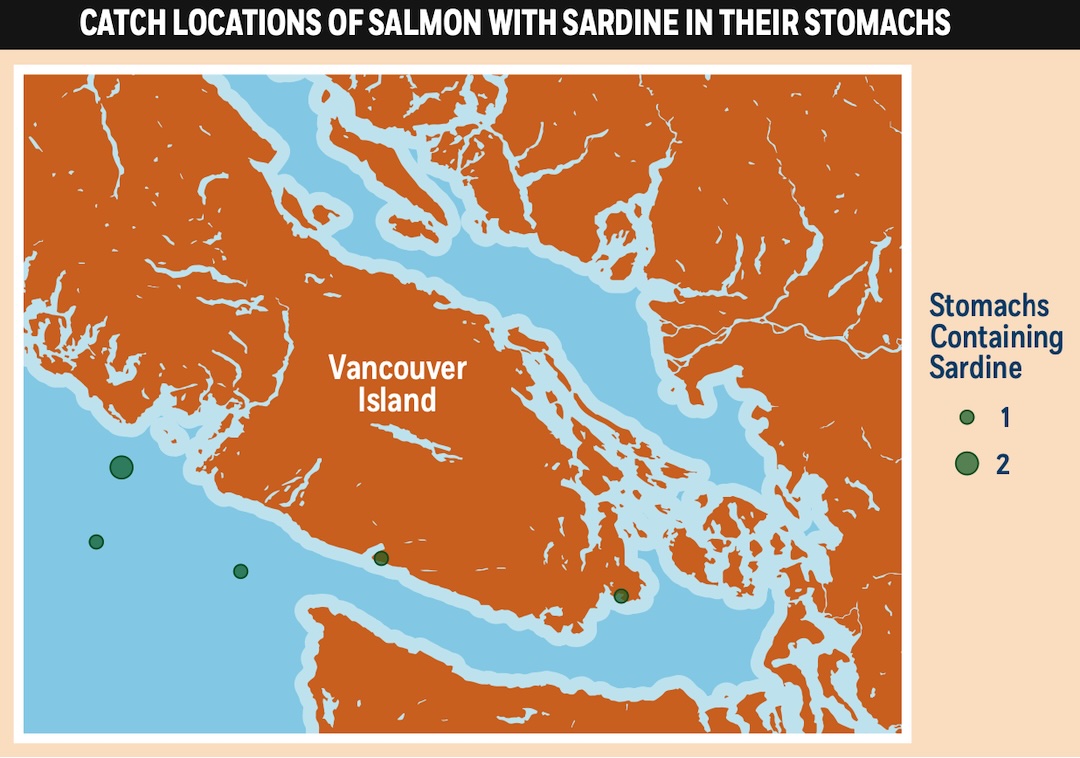
Anchovies as Salmon Food
Historically, anchovies have not been very common in British Columbia. Like sardines, the bulk of anchovy populations in the Pacific Northwest spawn further south along the coast. Past salmon diet studies in BC did not report anchovies at all, and other historical data shows that they have only been present in low numbers. However, in 2014 an increase in the number of anchovies was observed by anglers and surveyors in the Salish Sea. In fact, anglers observing anchovies in the stomachs of their salmon was part of the inspiration to begin this program.
Since 2017 we have observed anchovies in salmon stomachs all around BC. They are most commonly found in Howe Sound where they make up a significant proportion of salmon diets. Anchovies currently spawn in the Strait of Georgia, a notable change in the food web which has occurred in the last decade. Because anchovies spawn later in the season and grow more slowly than other forage fish, they may remain small enough to act as a winter food source for juvenile salmon. This may have important implications for their winter survival, which is a field of ongoing research.
Importance of Data Collection
It is important to document how marine ecosystems are changing in real time so that we can recognize and adapt to these changes. Understanding the distribution and abundance of species like sardine and anchovy is important for their management and the management of predators that rely on them as a food source. Salmon diet analysis is one way that we can do this, but without the involvement of anglers, this extensive sampling would not be possible.
We are very grateful for any and all samples provided. However, a few regions are of particular interest to us this year. We are in need of more samples collected from Howe Sound and Sunshine Coast as well as from the northwest coast of Vancouver Island. Due to reduced fishing activity in the spring and winter months, any samples collected during these seasons in any region are incredibly valuable to us. Additionally, fish caught in the summer mark-selective fishery will be of particular interest this year.
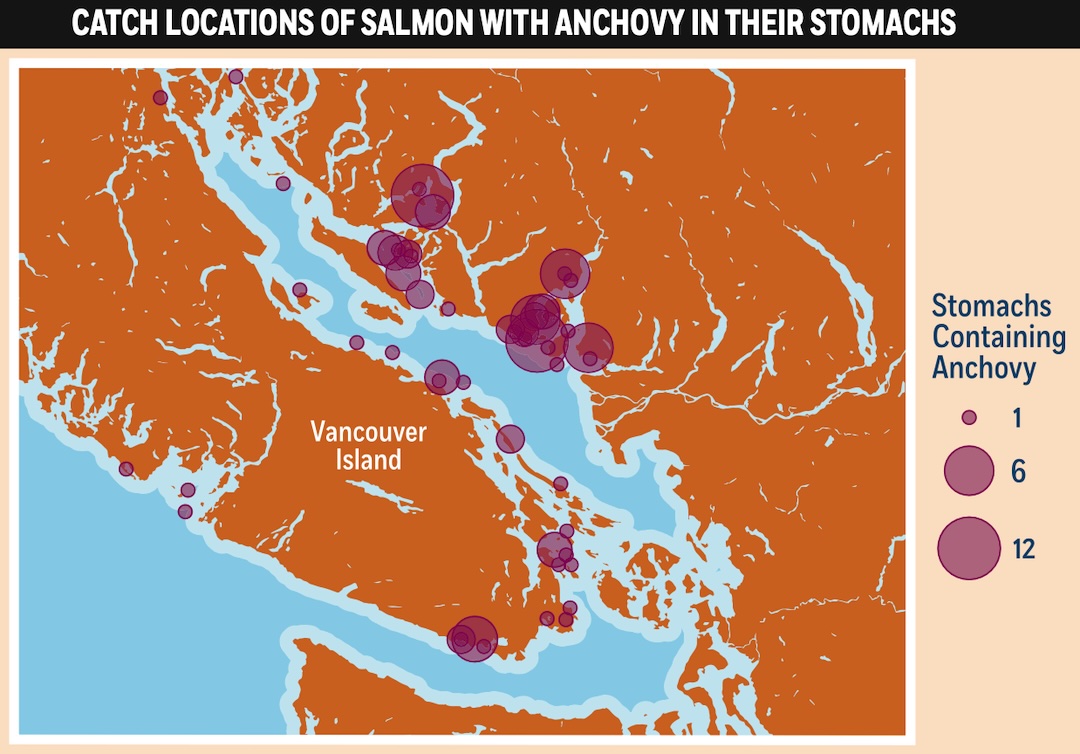
Submitting Salmon Stomachs—Win from the Growing Prize Pool
Every stomach submitted with a complete data card counts as an entry into our annual raffle. Previous years’ prizes have included an Islander MR3 mooching reel and Salish Sea Spoon Packs, generously donated by our sponsors Islander Reels and AP Tackleworks. This year the prize pool will also include an engraved Islander mooching reel donated by Islander Fisherman Magazine. Along with the chance to win these great prizes you will receive a personalized report summarizing your catch data as well as a summary of the program’s findings for the year. We hope that you will consider taking part in the Adult Salmon Diet Program.
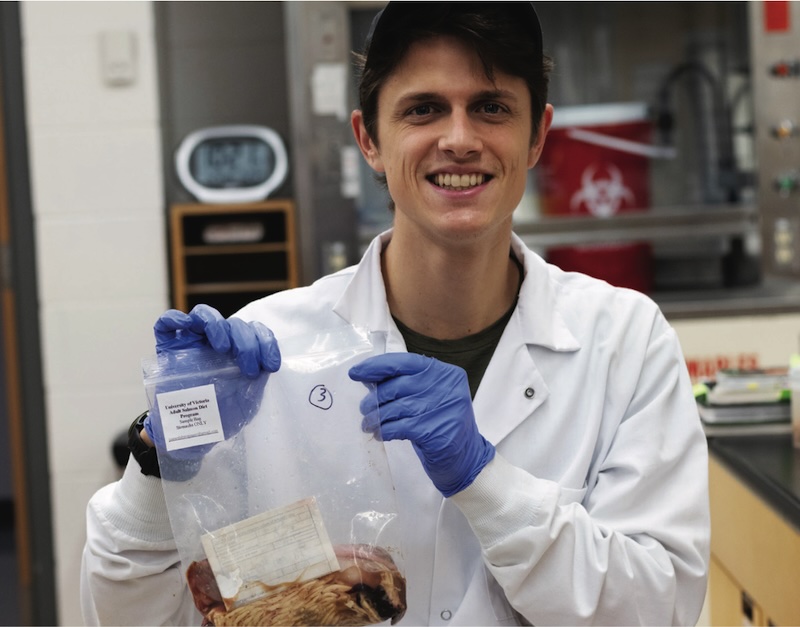
Make sure to submit your samples with complete data cards to keep the ASDP team smiling! (Photo: Kristina Duchscher)
Join Our Study!
Check out our website, follow us on Facebook, or contact us at uvicsalmondiet @ gmail.com to express your interest in taking part. We will get you set up with collection baggies and waterproof data cards (also available at collection depots or contact us to have them mailed to you). For every stomach, fill out a data card with all the key information (date, catch location, species, fork length). When cleaning your catch, place all of the organs in the collection baggy with the completed data card and freeze it as soon as possible. You can drop off your samples at one of our collection depots (see list below) or contact us to arrange a pickup.
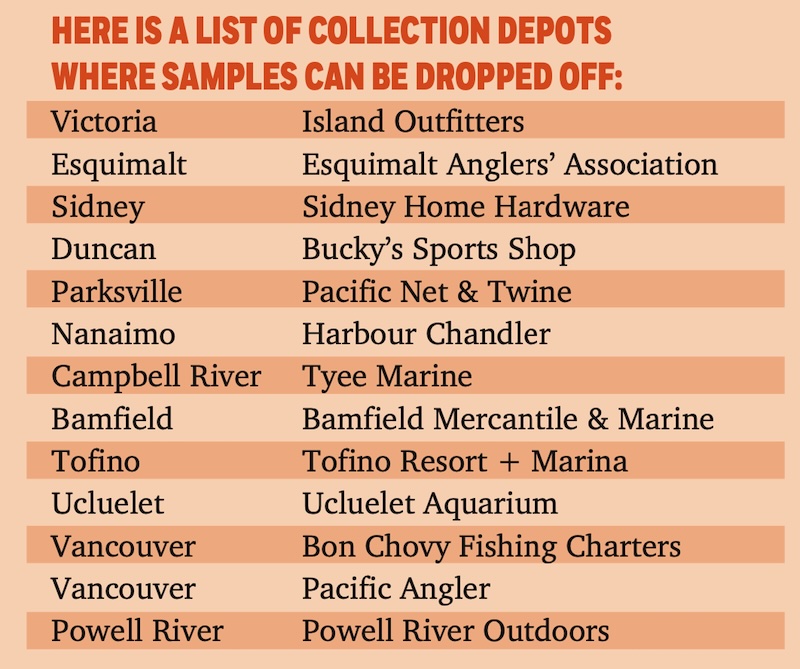
This article appeared in Island Fisherman Magazine. Never miss another issue—subscribe today!
Visit the Store
$34.99
$34.99
Featured Catch

Joel Unickow halibut (Photo: Rob Frawley Lucky Strike Sportfishing Tofino)
